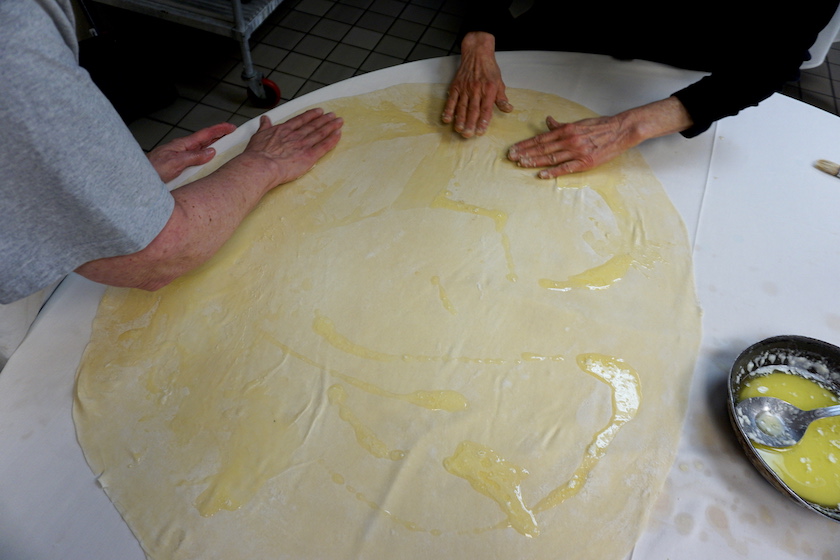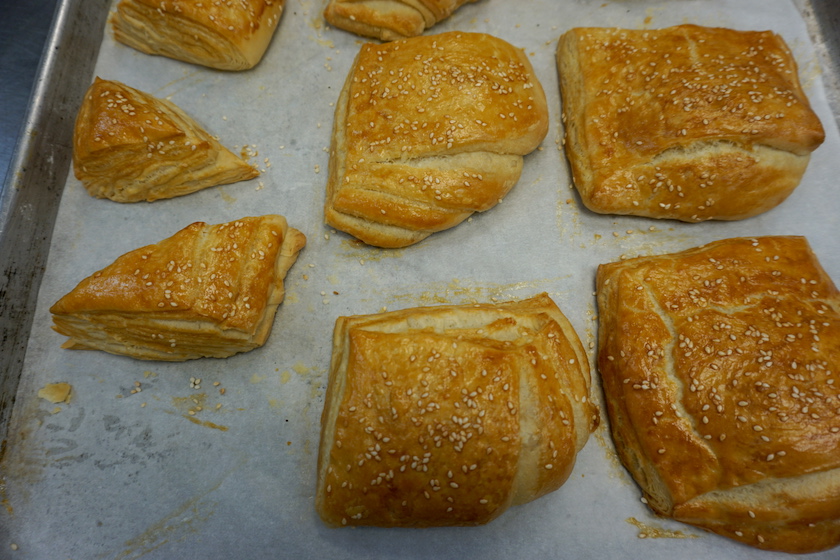Armenian Church Katah
No sooner had I entered the industrial kitchen of St. John's Armenian Church in Southfield, Mich., when I found myself hands deep in warm, melted butter.
Other people's hands were in warm, melted butter too. Some hands were flouring countertops, other hands were rolling dough with "okhlavoos," long dowels used in Middle Eastern cooking, even more hands were folding and stretching and a couple hands were sprinkling sesame seeds.
There was movement everywhere you looked, a sort of organized chaos amongst a group almost exclusively made up of women. Suddenly, that famous Margaret Thatcher quote had come to life: "If you want something said, ask a man; if you want something done, ask a woman."
This crew, members the St. John's Armenian Women's Guild, had started before 9 a.m. in a bid to make an old world specialty found exclusively at church bake sales and festivals: katah, an Armenian pastry that has many variations depending on where your family originates from.
Armenian-American communities in the West Coast, who, thanks to over 100 years of continued immigration that's still ongoing, have many restaurants, bakeries and delis where they can access the diverse fare that falls under the definition of Armenian food. Communities in many other regions in the U.S., don’t. That’s why church food sales and bakes have long been the holiest of places for more than one reason: the ability to stock up on every dough-based savory and sweet food item imaginable.
Ever since I landed in Detroit from Los Angeles two years ago, I have been fascinated by this. I grew up with my dad being able to go down the street to the Armenian bakery and bring back freshly baked bread that was still hot when he was cutting it at the table. I didn’t have to go to a festival or church bazaar to get the food I craved.
Built mostly after the genocide by survivors and descendants of survivors, churches served as spiritual centers, but their mission organically extended beyond religion. They became cultural and community centers, too. And in many areas like the Midwest, they were essential in keeping Armenian food traditions alive.
That's why I found myself amongst flour, butter and the hands that worked magic with them to make this puffy pastry that was the Armenian version of a croissant, eager to document how women's guilds like this one had an essential hand in preserving the recipes and food traditions of a people who were almost completely lost to history.
The other reason was selfish: cooking communally was an ancient practice I desperately wanted to experience.
Surrounded by women who spanned the Armenian experience - from third generation descendants of genocide survivors who remember stories of Armenian factory workers in Detroit earning $5 a day under Henry Ford's plan to Armenian immigrants from Aleppo whose families are in the process of escaping the destruction in Syria, to me - a child of Iranian-Armenian refugees who juggles both of those identities with being American, I felt like I was participating in something that went beyond food.
It was a ritual. When I pulled my fingers under the dough to stretch it out, when I dipped my fingers into the warm butter, soaking the thin layer in front of me, when I folded the dough over and over again and with the help of a partner, stretched it to the outer edges of our circular table, it was a series of repetitive motions that reflected something bigger than the dough itself.
We were in a modern kitchen, wearing jeans and carrying smartphones, but I suspect that beyond these details, we could have been in an Anatolian village a century ago. The dough would have been rolled, it would have risen and it would have been baked, filling the room with that recognizable scent when butter gloriously meets heat.
In between those crispy layers was a constant that could be pinpointed, a line that could be drawn back hundreds of years - a thing that did not change when so many things did.
When recipes like this survive war, genocide, forced migration and assimilation and still exist, when these hands continue to make them in, you get to witness it, it feels like kind of like a miracle.
Katah
2 packages active dry yeast
1/2 cup warm water, 1 tsp. sugar
4 large eggs
5 oz. evaporated milk
3/4 lb. melted butter
1/4 cup vegetable oil
2 cups warm milk
2 tbsp. salt
9 cups all-purpose flour
Spreading and Decorating
1/2 to 1 lb melted butter
3 eggs for egg wash
Sesame seeds
Combine the yeast and sugar in the warm water, allowing it to rest in order to proof. In a large bowl, combine eggs, evaporated milk, melted butter, vegetable oil, warm milk and salt. Add the yeast and sugar mixture and then add flour, 2 or 3 cups at a time. Stop adding flour when the dough is soft and sticky. Knead the dough to achieve silkiness.
Divide dough into 1 lb. portions, rolling each into a smooth ball. Place on floured trays and cover each tray with a plastic bag in order to let it rise for 30 minutes.
Sprinkle flour on a table and place a ball directly on the flour. Then, cover the ball with another handful of flour. Using a rolling pin, roll the center out all the way around to the edges, creating a large circle.
Switch to the dowel ("oklhavo," which you can find at hardware stores and have them shape it for you), continue rolling until the circle is approximately 2/12 to 3 feet in diameter.
Transfer the dough to another table and use your fingers to gently stretch out the edges. Brush melted butter evenly across the entire surface - not too much or too little, but just enough to cover the dough. You can also use your hands instead of a brush.
Fold one end of the circle inwards, then fold the opposite side inwards, basically folding in thirds. Spread more butter over your folded dough and then fold again in half, lengthwise. You'll end up with a long narrow piece of dough.
Placing one hand underneath the end of the dough and the other hand towards the middle, stretch the dough by gently banging it up and down on the table (it helps to have a partner for this who can hold the other end and stretch it out at the same time).
Begin fold the dough from one end to the other, in 6 inch squares.
Place on tray, cover with towel and refrigerate for 30 minutes. Repeat this process for all of the balls.
Using a regular rolling pin, roll out the dough to approximately 1/2" to 3/4" thick. Place on a tray to rise. After they have doubled in size, coat with egg wash and sprinkle with sesame seeds. Bake in preheated 375 degree oven for 25 minutes or until golden brown.
Yield: 9 Katahs
Recipe adapted from "Armenian Cuisine: Preserving Our Heritage," a comprehensive collection of over 450 recipes from the Detroit metropolitan area published by the Women's Guild of St. John's Armenian Church in Southfield, Michigan. Copies are available for purchase via their website.





